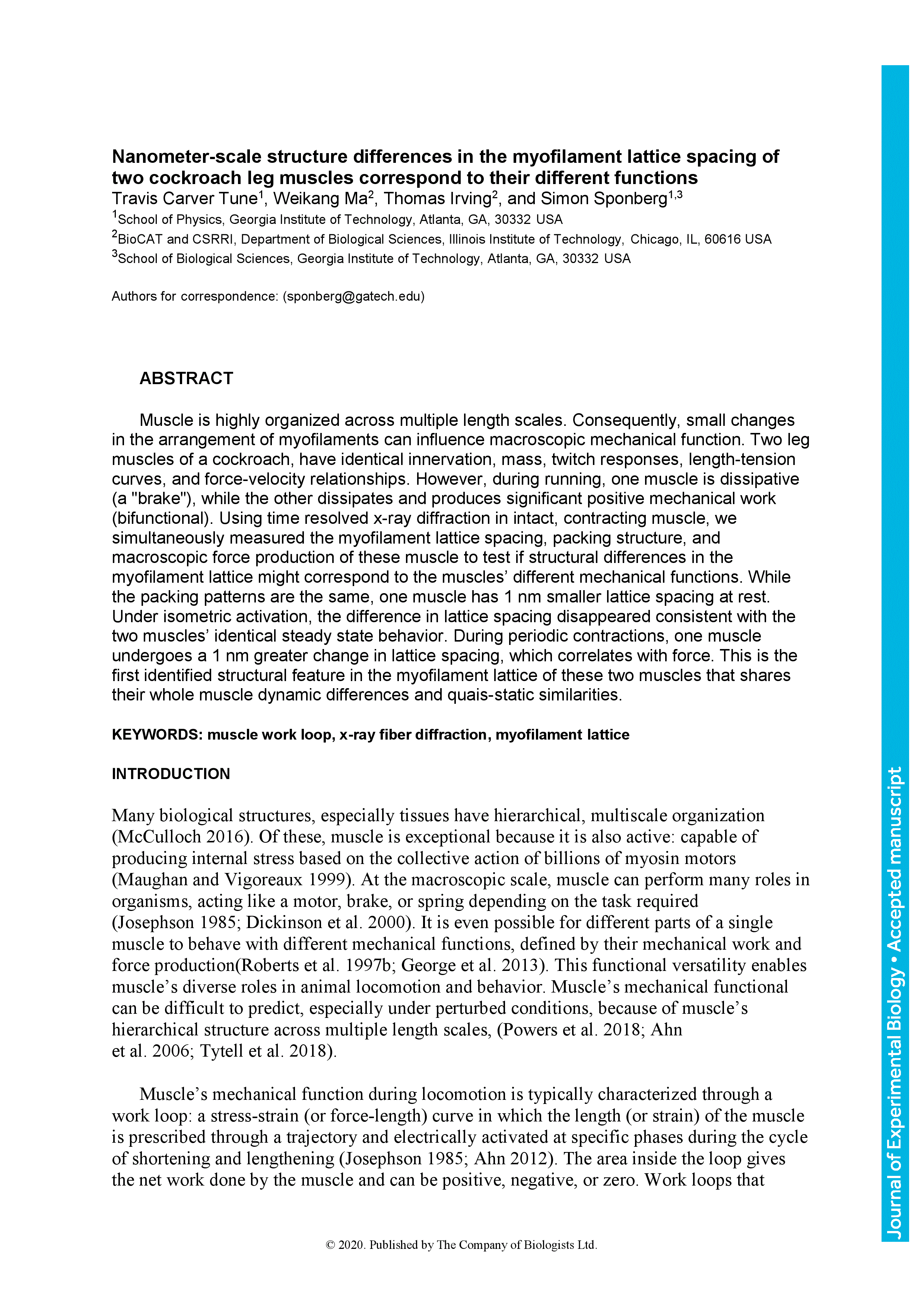Muscle is highly organized across multiple length scales. Consequently, small changes in the arrangement of myofilaments can influence macroscopic mechanical function. Two leg muscles of a cockroach, have identical innervation, mass, twitch responses, length-tension curves, and force-velocity relationships. However, during running, one muscle is dissipative (a “brake”), while the other dissipates and produces significant positive mechanical work (bifunctional). Using time resolved x-ray diffraction in intact, contracting muscle, we simultaneously measured the myofilament lattice spacing, packing structure, and macroscopic force production of these muscle to test if structural differences in the myofilament lattice might correspond to the muscles’ different mechanical functions. While the packing patterns are the same, one muscle has 1 nm smaller lattice spacing at rest. Under isometric activation, the difference in lattice spacing disappeared consistent with the two muscles’ identical steady state behavior. During periodic contractions, one muscle undergoes a 1 nm greater change in lattice spacing, which correlates with force. This is the first identified structural feature in the myofilament lattice of these two muscles that shares their whole muscle dynamic differences and quais-static similarities.
Nanometer-scale structure differences in the myofilament lattice spacing of two cockroach leg muscles correspond to their different functions
Currently Viewing Accepted Manuscript - Newer Version Available
- Split-screen
- Views Icon Views
- Open the PDF for in another window
-
Article Versions Icon
Versions
- Version of Record 04 May 2020
- Accepted Manuscript 01 January 2020
- Share Icon Share
-
Tools Icon
Tools
- Search Site
Travis Carver Tune, Weikang Ma, Thomas Irving, Simon Sponberg; Nanometer-scale structure differences in the myofilament lattice spacing of two cockroach leg muscles correspond to their different functions. J Exp Biol 2020; jeb.212829. doi: https://doi.org/10.1242/jeb.212829
Download citation file:
Advertisement
2023 JEB Outstanding Paper Prize shortlist and winner

The JEB Editors are delighted to announce the shortlisted authors for the 2023 JEB Outstanding Paper Prize. Read the winning paper - Tiny spies: mosquito antennae are sensitive sensors for eavesdropping on frog calls - by Hoover Pantoja-Sanchez and Brian Leavell from Ximena Bernal's lab at Purdue University, USA.
JEB Science Communication Workshop for ECRs

If you’re an early-career researcher interested in science communication and are attending the SEB Annual Conference in Prague this summer, come a day early and join the JEB Editors at a sci comm workshop to learn the key writing skills needed to promote your research to a broad audience beyond your peers (1 July at 14.30-17.30). Places are limited to 24 attendees, and applicants should apply through the SEB registration page by 30 April 2024.
Bridging the gap between controlled conditions and natural habitats in understanding behaviour

Novel technologies enable behavioural experiments with non-model species, in naturalistic habitats and with underexplored behaviours. In their Commentary, Scholz and colleagues discuss how to obtain a deeper understanding of the natural ecology and lifestyle of study animals.
Beluga metabolic measures could help save species

To help save animals from extinction, it’s important to understand what each species needs to survive. This led Jason John et al. to measure the metabolic rates of captive belugas to develop a ‘fish calculator’ showing that the whales need to eat ~23 salmon per day.
ECR Workshop on Positive Peer Review

Are you an ECR looking for tips on how to write concise, astute and useful manuscript reviews? If so, join the JEB Editors at a 2-hour JEB-sponsored Workshop on Positive Peer Review at the Canadian Society of Zoologists annual meeting in Moncton on 9 May 2024 at 13.00-15.00. There are 25 spaces for ECRs and selection is first come, first serve. To sign up, check the ECR Workshop box when you register for the CSZ meeting.



